All fish need cover at some point in their lives, so some aquatic vegetation is good. However, if left unchecked, aquatic vegetation can become a real threat to the health of your fishery.
Some Aquatic Vegetation is a Good Thing
We talk about it all the time - all fish need cover at some point in their lives. Vegetation often is a great source of cover in private lakes and ponds for a variety of reasons, but it can get out of hand quickly if not managed properly. So, if you have a lake or a pond on your property, at some point in time, you're probably going to have an issue with aquatic weeds.
Prevention vs. Treatment of Aquatic Vegetation
Aquatic vegetation growth rates typically kick into high gear when water temperatures are consistently above 60 degrees.
As the old saying goes, an ounce of prevention is worth a pound of cure. We have several blog posts about pond management options for aquatic weeds, native vegetation and trees, where you can read more about prevention and management.
Options for Aquatic Vegetation Management
One of the most effective ways to prevent aquatic vegetation from getting out of hand is by limiting the amount of sunlight reaching the bottom of your pond.
Dyes and Fertilizers Can Reduce Pond Visibility
You can reduce sunlight depth by either dying or fertilizing your pond or lake - and which technique you choose will be dependent on the size of your fishery.
Unfortunately, even with constant vigilance, weeds usually find a way to proliferate. When that happens, knowing how to control the weeds without harming your fishery is paramount.
Important Notes about Treating Aquatic Vegetation
Not all vegetation is bad.
In fact, fish have lower mortality and the ecosystem generally yields better quality offspring when there is some vegetation in your fishery.
Information on the Types of Aquatic Vegetation
To learn about the different types of aquatic vegetation and their respective pros and cons, check out our blog "Types of Aquatic Vegetation."
But if it gets out of hand, here are several important notes to keep in mind when treating aquatic vegetation:
- If you decide to use a chemical treatment, it is imperative that you purchase products rated for aquatic use.
- Follow the instructions on the label, for application rate, targeted species, and protective equipment. For more information about application rates, please contact us directly.
- Only treat a small portion (20%-25%) of the total pond surface area at a time. This will prevent depletion in dissolved oxygen concentration as the plant biomass decomposes. Additionally, we recommend waiting 2-3 weeks between treatments. And, if there are multiple species present that require different chemicals, focus on the most prevalent first and work one species at a time.
- When using chemical treatments in elevated water temperatures during the summer, treat a smaller portion than normal. Dissolved oxygen concentrations decrease as water temperatures increase, also increasing the risk of oxygen depletion, so you need to exercise additional caution in this scenario.
You can read more about these cautionary warnings to learn more about the herbicides that could kill your fish before treating your private lake.
Identifying, Treating, and Preventing Aquatic Vegetation
Here is a list of the aquatic plants which are most likely to be out of control in private lakes, and our respective treatment recommendations to control vegetation.
*If you don't see your particular problem plant here, Pond King can still help you get it under control; it just means it isn't something we see a lot here in North Central Texas.
Aquatic Vegetation Identification
American pondweed:

We have some customers who add American pondweed to their pond because it helps attract waterfowl.
American pondweed typically roots in shallow water and is characterized by blade-shaped floating leaves.
A small seed head will protrude above the water's surface on a small stalk during the summer. Unfortunately, while it may help attract ducks to your pond, this native plant can quickly get out of control.
American Pondweed Treatment and Control Options
- Chemical treatment for American pondweed.
Our biologists recommend a product called Aquathol K, a dipotassium salt of endothall as a contact herbicide.
Aquathol K should be treated at a rate of 1.5 gallons per acre-foot of water (liquid) or 13lbs pounds per acre-foot of water (granular). A systemic herbicide option for treating American Pondweed would be Sonar RTU (liquid), or Sonar One (granular) containing the active ingredient Fluridone. Systemic herbicides act slower than contact herbicides as they must be absorbed by the plants in order to move to a sight of activation. - Pond management techniques for managing American pondweed.
Since American pondweed grows from the bottom up, a very effective biological control method is Triploid Grass Carp.
Even though these fish are sterile (triploid), they are considered an invasive species, and if you live in Texas, you will need a permit from the Texas Parks and Wildlife Department to stock them. You can apply for that online at tpwd.org.
Bushy pondweed (Southern Naiad):

Like American pondweed, Bushy pondweed is a native plant that roots in the bottom of the pond and grows up to the surface.
It has thread-like narrow leaves with microscopic teeth along the edges. The leaves grow opposite each other on slender, sparsely branched stems, and the plant reproduces by seed germination and fragmentation, like Bermuda grass.
Bushy pondweed prefers water with a high mineral content (hard water) and can be found growing in water ten or more feet deep.
Bushy Pondweed Treatment and Control Options
- Chemical treatment for Bushy pondweed.
While Flurodine is also an option for treating Bushy pondweed, we typically recommend a Diquat such as Reward or an Dipotassium salt of endothall such as Aquathol K or Aquathol Super K Granular instead. - Pond management techniques for managing Bushy pondweed.
Grass Carp can be very effective in managing Bushy pondweed.
We have had customers ask what to feed their Grass Carp once they have eaten all the weeds, but don't worry. The Grass Carp don't kill the plants, so they continue to provide nutrients to the Carp. But, once your Carp reach full maturity, they won't eat as much, so you may need to restock them to continue with adequate vegetation control.
When that happens, you may need to reapply for a new Grass Carp permit.
Cattails, Bulrush and Reeds
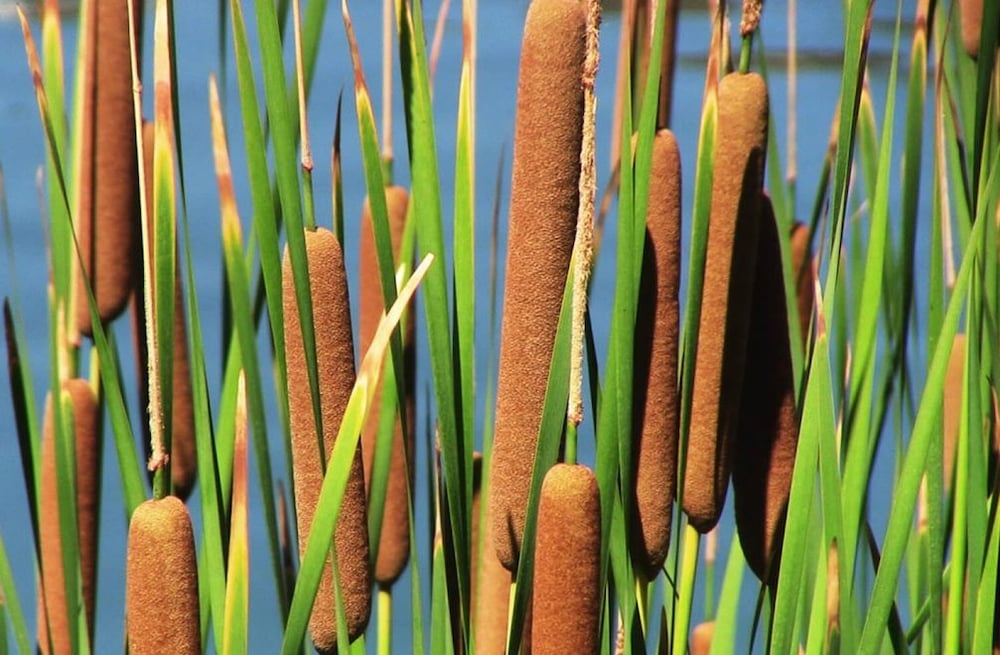
With their brown cigar-shaped head that stands atop a very long, stout stalk, Cattails are easy to identify.
Cattails are perennial plants that can provide many benefits to your fishery.
Benefits of Cattails
They provide hiding places for your juvenile fish, habitat for redwing blackbirds and other species, and are shockingly nutritious for humans.
They can help with erosion control and have even been found to filter pollutants.
Dangers of Cattails if Left Unmanaged
The plant emerges from creeping rhizomes which can spread along your shoreline and, if left unchecked, can turn your beautiful pond into a marsh and, eventually, an open field.
Treatment Options for Controlling Cattail Plants
- Chemical treatment for Cattails.
If your Cattails are getting out of control and you aren't quite adventurous enough to harvest them for the dinner table, we recommend using aquatic-rated glyphosate at a mixture of 8 oz per gallon of water with the addition of a surfactant. The brand we carry is ShoreKlear-Plus.
You'll want to spray the herbicide on the area with Cattails when they are at least 12 inches out of the water. When the Cattails turn brown and wilt, remove them using a rake.
If you don't get the entire plant, including the roots, the Cattails will decompose and provide excellent fertilizer for next year's crop, which defeats the point of removing them in the first place. - Pond management techniques for managing Cattails.
If you are adding Cattails to your pond for aesthetics, a great way to control them is to plant them in pots to prevent the rhizomes from spreading.
If they do get out of hand, non-chemical methods of control include hand pulling, mowing, and cutting.
Chara

Also known as Skunkweed or Muskgrass, Chara is a gray-green branched alga often confused with submerged rooted plants.
Characteristics of the Chara Plant
Chara has no flower, does not extend above the water's surface, and usually has a grainy or crunchy texture because of the calcium deposits on its surface.
Chara has cylindrical, whorled branches with six to sixteen "branchlets" around each node, and if you break it, you'll notice a musky odor - hence the common name Skunkweed.
Treatment Options for Controlling Skunkweed
- Chemical treatment for Skunkweed.
For treating Chara, we recommend either Cutrine Plus (liquid) or Cutrine Plus Granular.
We prefer the Granular because waters treated with this product may be used for swimming, fishing, further potable water treatment, livestock watering or irrigating turf, ornamental plants, or crops immediately after treatment.
Don't use either chemical in ponds with Koi or hybrid goldfish. - Pond management techniques for managing Skunkweed.
Even though Chara is technically algae, if you want to use a biological method of controlling this plant, you should stock Triploid Grass Carp.
In Texas, the state will determine the appropriate number of fish for your pond. But, typically, you will want five Carp per acre if the water body has less than 50% plant coverage and 10 per acre if plant coverage is greater than 50%.
Coontail
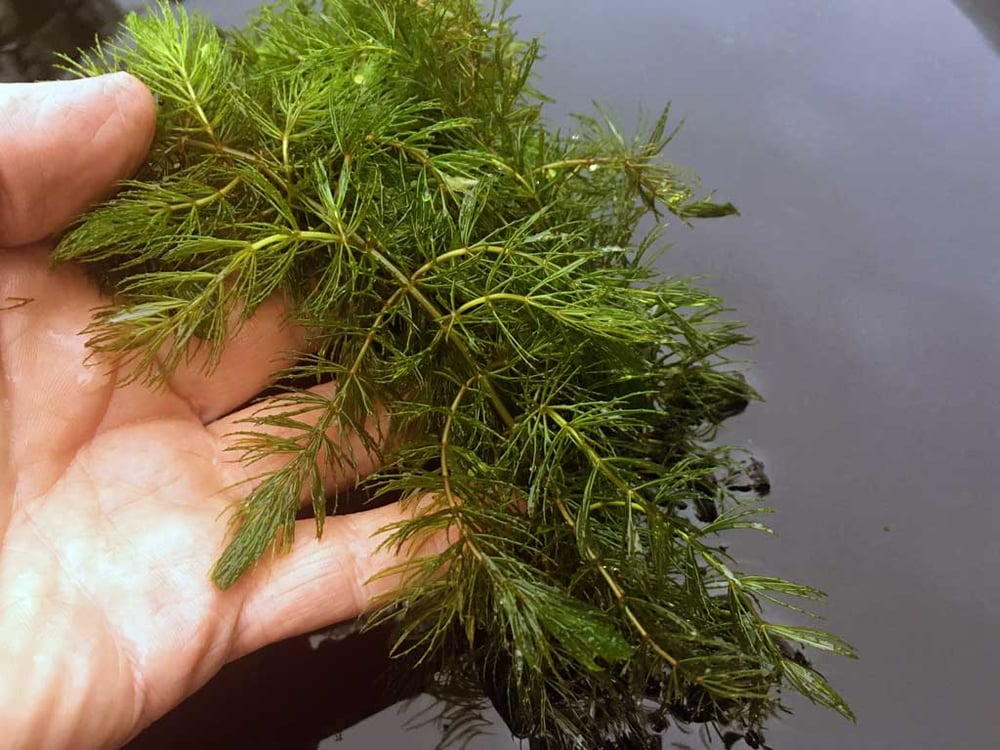
Coontail is a bushy-looking grass with whorls of stiff, forked leaves along densely branched stems, resembling a raccoon's bushy tail - especially when submerged.
Despite its appearance of growing from the bottom up, Coontail does not have a root structure to hold it in place, so it can move and amass along the shore.
Like so many other weeds, it can provide food and habitat to fish and waterfowl throughout the year. But, it can hinder fishing and contribute to oxygen depletion when it gets out of control.
Treatment Options for Controlling Coontail
- Chemical treatment for Coontail.
To chemically control Coontail, we use Reward or AquatholK. - Pond management techniques for managing Coontail.
The biological control for Coontail is Triploid Grass Carp. You will want five Carp per acre if the water body has less than 50% plant coverage and 10 per acre if plant coverage is greater than 50%.
If you live in Texas, you need a Texas Parks and Wildlife Department Triploid carp stocking permit to stock this invasive species in your fishery legally.
Creeping Water Primrose
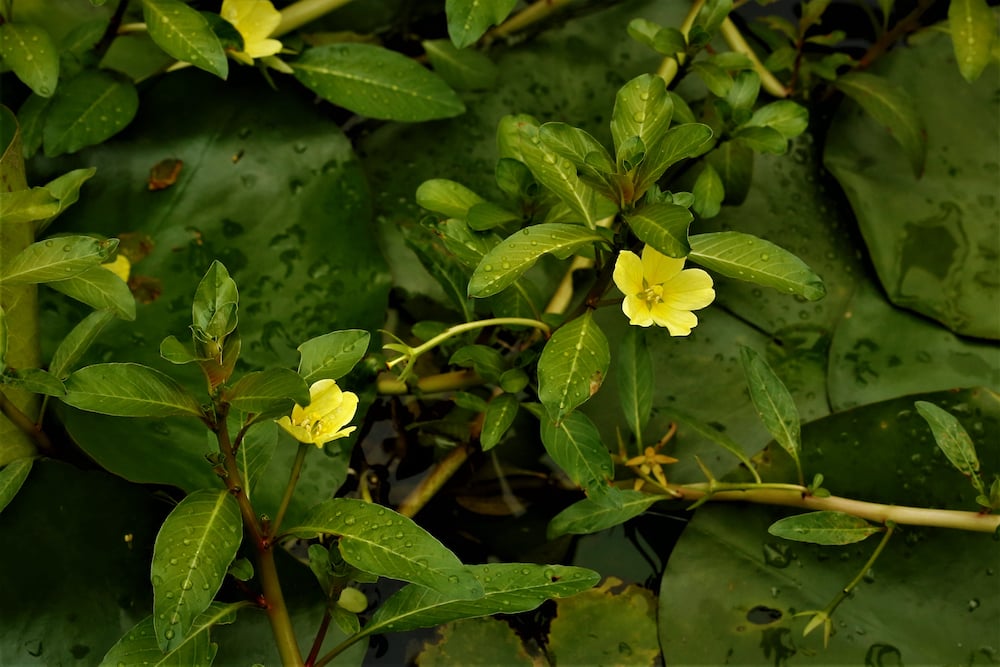
This is a highly invasive species that offers very little benefit to a fishery and can cause many problems.
Water Primrose is a perennial plant that grows along the shoreline and can become a breeding ground for mosquitoes and degrade the water quality for fish and wildlife.
Water Primrose can be identified by its dense, sprawling mat of alternately arranged, slightly hairy, willow-like leaves and bright, yellow flowers, usually with five petals.
Treatment Options for Controlling Primrose
- Chemical treatment for Creeping Water Primrose.
If you notice any Water Primrose, we recommend you treat it immediately to prevent it from becoming a problem.
Because it is such an invasive species, we recommend physically removing the plant and then treating the area of infestation with aquatic glyphosates, like ShoreKlear-Plus. - Pond management techniques for managing Water Primrose.
There is no managing Water Primrose. If you have it, you want to get rid of it. At the time of this post, the only form of suggested biological control is goats because, let's face it, goats will eat almost anything.
But, removal and chemical treatments are your best options.
Duckweed
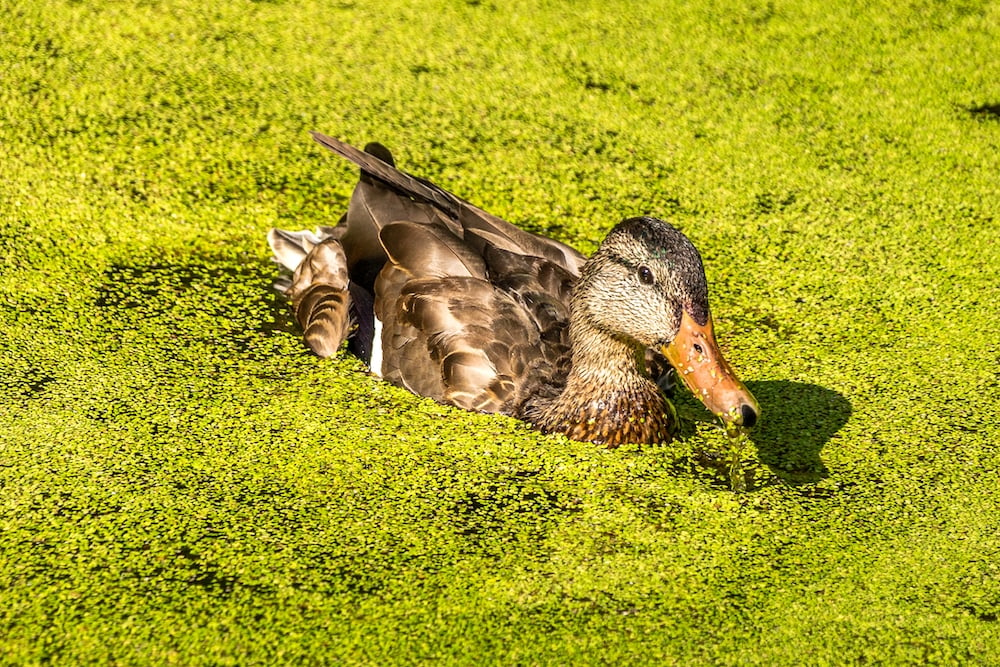
A small, green, free-floating plant that is sometimes used to attract waterfowl.
Unfortunately, ducks often cannot consume enough of it to keep it under control, and it can quickly get out of hand. In addition, if Duckweed covers the entire surface, it can cause a noticeable reduction of dissolved oxygen content—which can cause fish kills.
Treatment Options for Controlling Duckweed
- Chemical treatment for Duckweed.
Unlike diquat, an herbicide that kills plants on contact, Fluridone is a systemic herbicide that moves slowly into plants to kill them. As a general rule, Fluridone, in the format of Sonar RT, is very effective for the control of Duckweed because it doesn't just destroy the foliage; it kills the roots as well. - Pond management techniques for managing Duckweed.
There are several non-chemical options for preventing and controlling Duckweed: you can stock Mozambique Tilapia, add aeration, or both. Tilapia will help control the Duckweed and any filamentous algae you might have and are also excellent forage for your largemouth bass. Depending on the Duckweed coverage, you'll want to stock 15-30 pounds of Tilapia per acre. Some Texas counties require a permit to stock Tilapia.
Since Duckweed prefers slow-moving, stagnant water, aeration can help discourage growth - and is great insurance against a fish kill caused by oxygen depletion.
As you can see, choosing both these options has benefits beyond weed control. If your budget allows, we recommend both for a healthy Bass fishery.
Filamentous algae
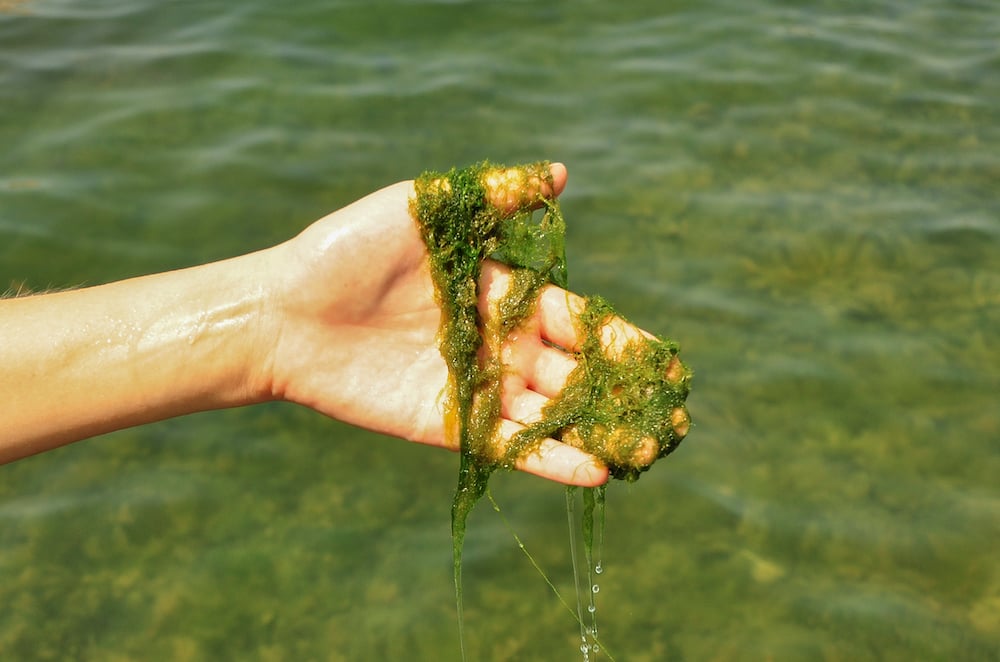
Filamentous algae is often found attached to other plants, sticks, leaves, rocks, and mud, and resembles mats of wet wool, hair, cotton, or slime.
Filamentous algae is typically a greenish color but can become yellowish, grayish, or brownish. Filamentous algae occur naturally in most surface waters, and as it grows, it stretches to the surface and often breaks up, lending new growth to be transported around the pond by wind and wave action.
Treatment Options for Controlling Filamentous Algae
- Chemical treatment for Filamentous algae.
Our chemical of choice for treating Filamentous algae is Cutrine, but we chose between liquid or granular based on the amount of growth. So if you have a lot of Filamentous algae, say 30% coverage or more, we recommend the liquid. But, if you only have moderate amounts of coverage, or less than 30%, then we recommend the granular.
In either situation, you only want to treat small areas at a time, especially if the water temperature is over 70 degrees.
Otherwise, you could deplete the oxygen levels in your fishery, causing a fish kill. - Pond management techniques for managing Filamentous algae.
Like Duckweed, there are several biological control methods for controlling Filamentous algae: you can stock Mozambique Tilapia, add aeration, or both.
Tilapia will consume filamentous algae and are also excellent forage for your largemouth bass.
We recommend stocking 10-15 pounds of Tilapia per acre to control Filamentous algae.
Adding aeration can also discourage growth - and is great insurance against a fish kill caused by oxygen depletion. If your budget allows, we recommend both for a healthy Bass fishery.
Lily Pads
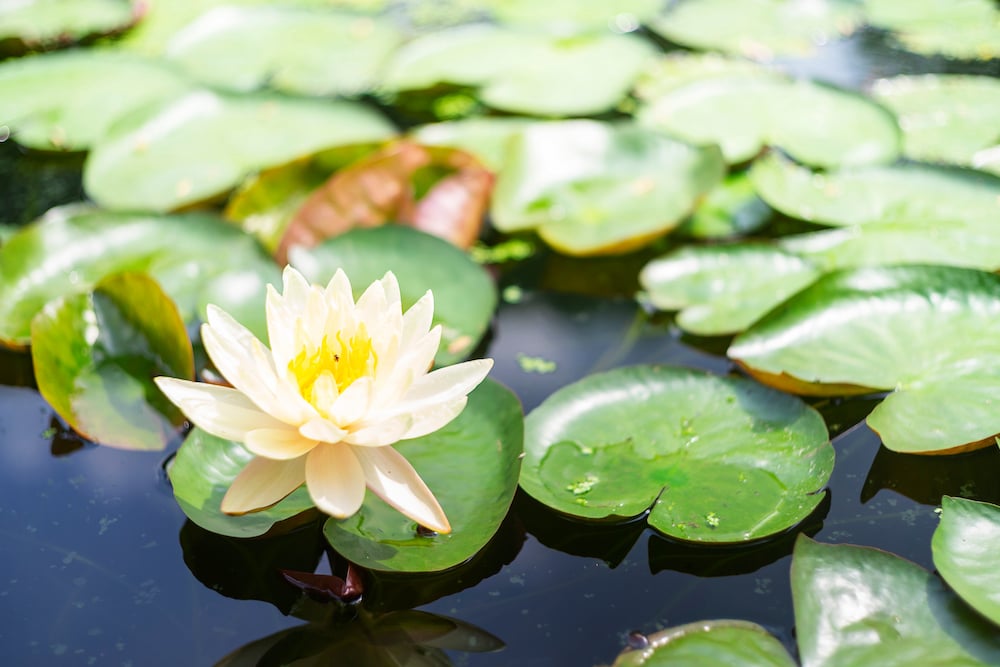
Lily pads are often added to ponds and lakes to enhance aesthetics and provide cover for your fish, especially in Koi ponds. They are lovely plants with broad, green leaves and white or yellow flowers that bloom throughout the summer.
Unfortunately, while they can add charm and beauty to your ponds and lakes, they can easily get out of control, making it difficult to fish and, as with other aquatic vegetation, increase the likelihood of an oxygen depletion event.
Treatment Options for Controlling Lily Pads
- Chemical treatment for Lily Pads.
To chemically treat Lily Pads, we recommend a combination of ShoreKlear-Plus, an aquatic-rated glyphosate, combined with a surface-active agent, such as Cygnet Plus. - Pond management techniques for managing Lily Pads.
Since nearly all fish species will appreciate the cover Lily Pads provide, no species will contribute to their biological control.
The two best options for controlling lily pads are:
- Plant them in pots to limit their spread.
- Lily Pads like stagnant water, so surface aerators and fountains can help contain their spread.
Chemical Pond Weed Control Precautions
Because it is so important, it is worth mentioning again, if you have a problem with an aquatic weed infestation, you must use extreme caution when using a chemical treatment:
- Only use herbicides rated for aquatic use.
- Follow the label.
- Only treat small areas of the pond's surface at a time.
- Don't treat when the ambient temperature is above 80-degrees.
Pond King Can Help with Your Aquatic Vegetation Control
If you are having a problem with an aquatic weed or plant we haven't covered here, please feel free to contact us or call to ask a pro to help you identify the plant and figure out how best to manage it.
We'll see y'all down at the pond!




